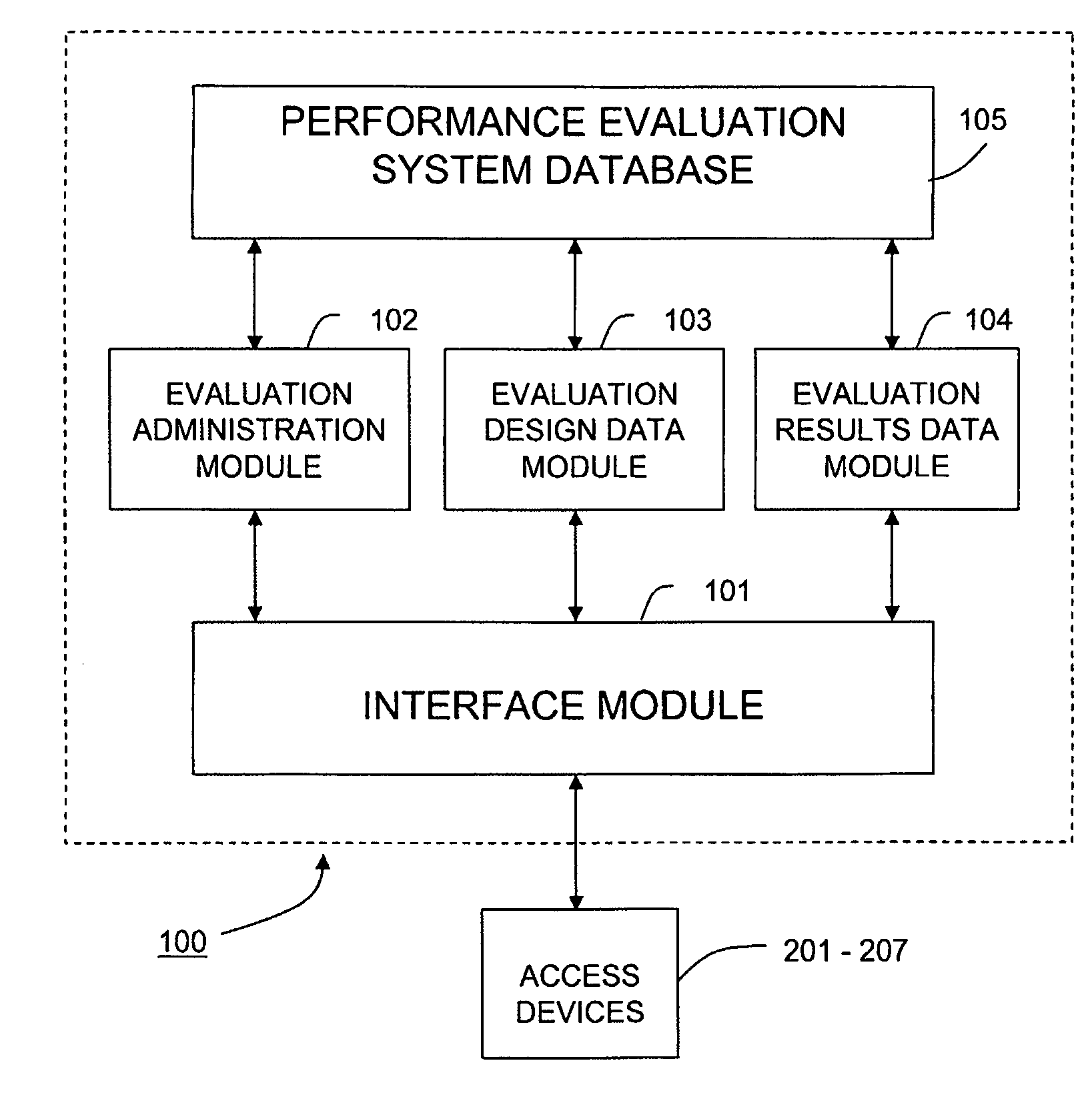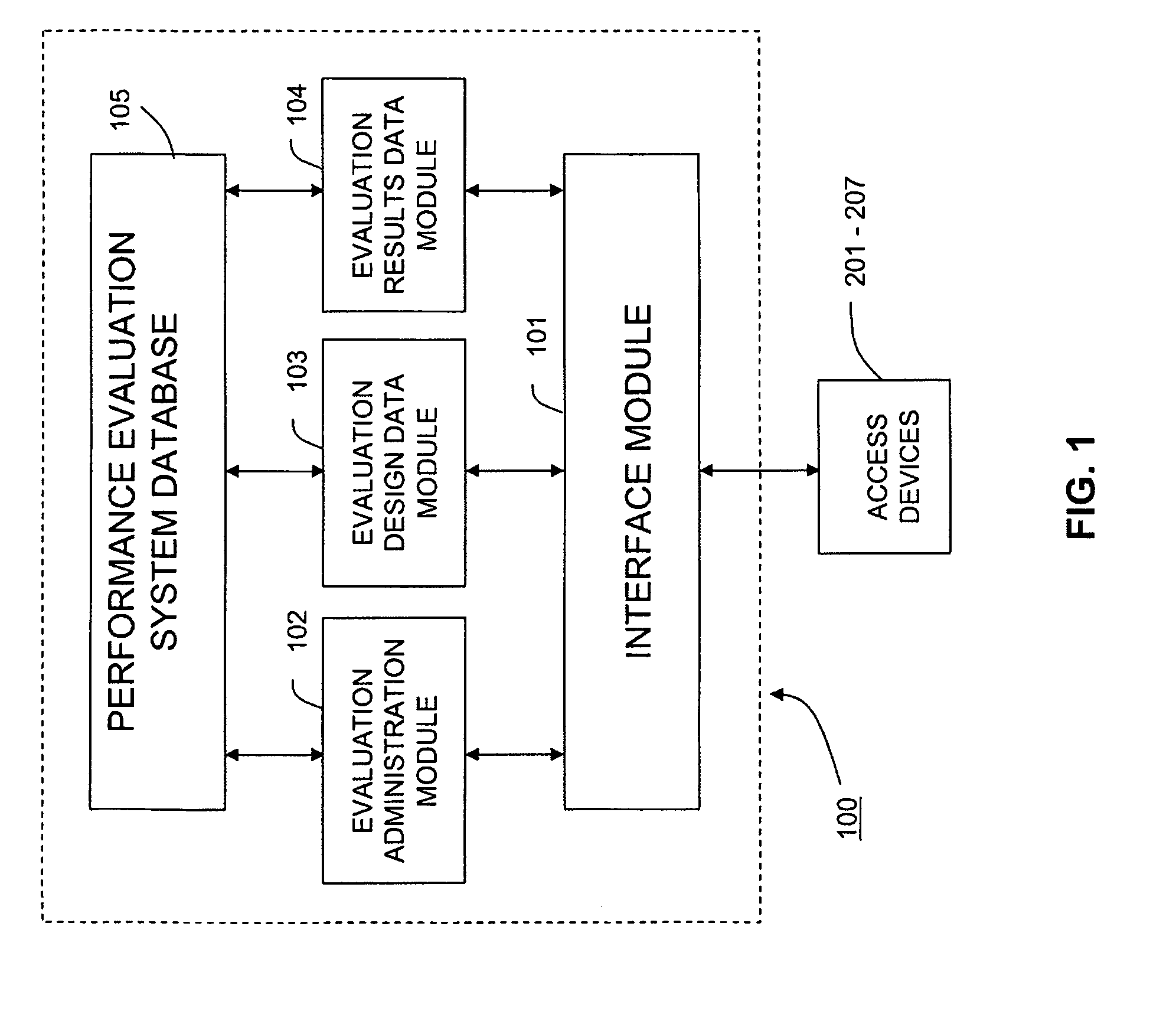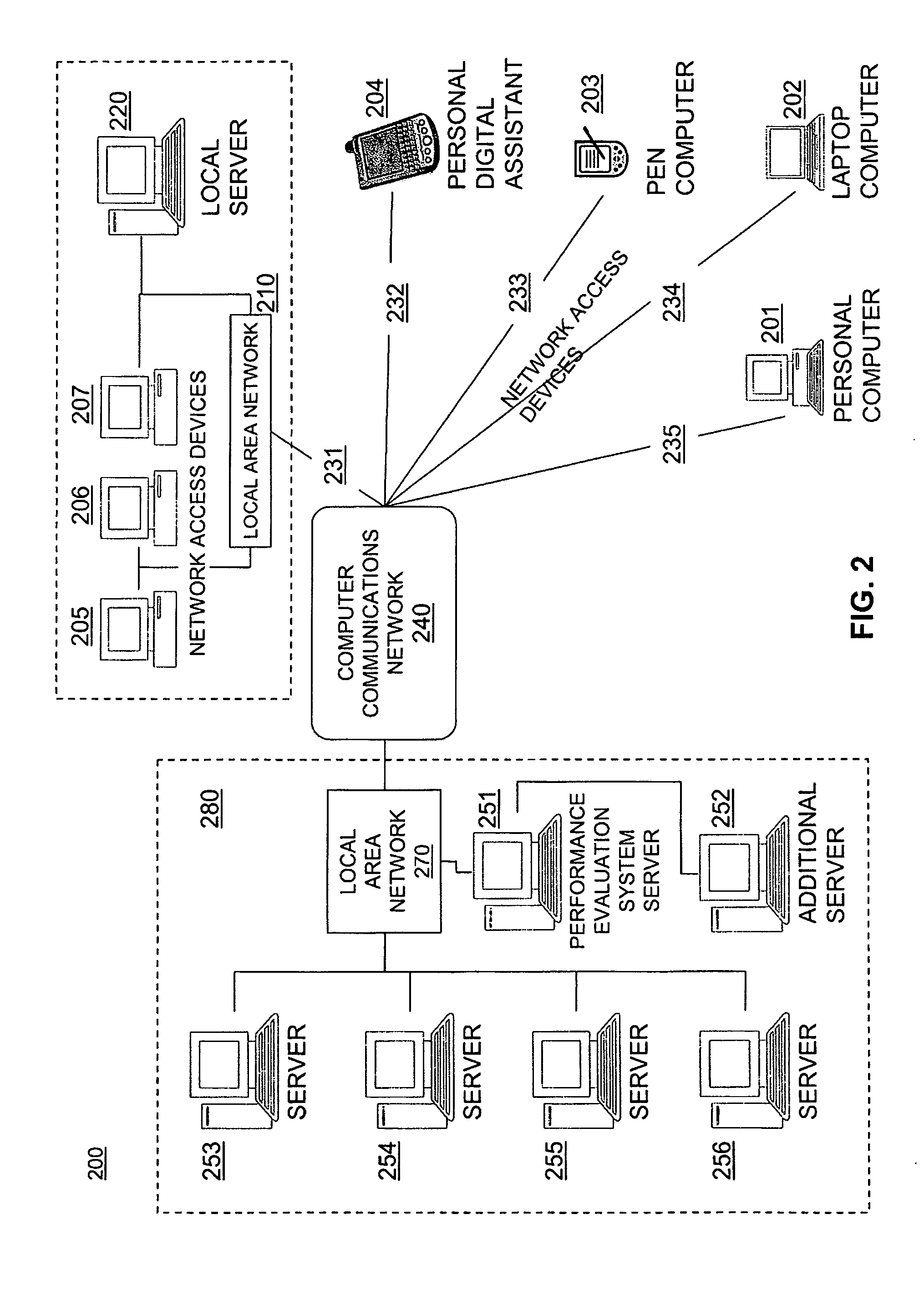Typically, employee performance ratings for either medium or large organizations are criticized or simply rejected.
In practice, the failure to perform accurate and reliable performance ratings is one of the primary causes of the fairly common failure of performance evaluation systems [Armstrong 1999:41] and [Cardy 1994:2].
Prior art methods exist that are used for rating the performance of employees and all of them have major drawbacks.
The Mixed Standard Scale is found to be difficult and expensive to develop.
A leniency error refers to a rating error that occurs when a person evaluating, hereafter called “rater”, has a tendency to steer away from assigning average and lower ratings.
The halo error is perhaps the most common rater error.
It refers to a rating error that occurs when a rater gives favorable ratings to all job factors based on impressive performance in just one job factor.
In addition, it does not allow self-monitoring by the employee.
In addition, it does not allow self-monitoring by the employee [Latham 1994:78].
Regarding the Graphic Rating Scale, the major criticism leveled at them is that their anchors are ambiguous and not defined in behavioral terms.
A consequence of this
ambiguity is that it is difficult to compare the meaning of ratings across raters and the persons to evaluate, hereafter called “ratees”.
The major limitation of this rating method lies with its
ambiguity and the extent to which such
ambiguity may result in inflation of ratings (leniency) [Cardy 1994:69-72].
Even if the rationale of Smith and Kendall in 1963 when they introduced the Behaviorally Anchored Rating Scale, also known as Behaviorally Expectation Scale, was to remove the ambiguity associated with the Graphic Rating Scale, way too much ambiguity remains.
Firstly, because too few anchors are used along the scale in order to clarify the meaning of effective or ineffective performance.
Nevertheless, other problems arise when anchors are too specific.
For example, if the ratee performance level does not correspond sufficiently to anyone of the scale anchors because they are too specific, it is difficult to use them as a guide for rating performance.
Such recording and comparing operations are very
time consuming and inefficient.
Several problems arise from this method.
A major drawback to this rating method is that the frequency rating scale is too ambiguous.
It is not realistic to require a rater to be held accountable for ascertaining whether a person literally did something 95 percent of the time versus 92 percent of the time.
In practice, doing this will simply confused raters, as they would need to keep track of the differences between each frequency scale about the meaning of their respective intervals.
In addition, if using a large inventory of behaviors meets the purpose of the method, which is to develop employees, evaluating those behaviors becomes very
time consuming.
Causes of prior art rating scales drawbacks and consequent failures of performance evaluation systems can be categorized into four categories, problems related to psychometric capabilities, to qualitative capabilities, to their costs to the organization and to their
quality control.
Regarding rating scales psychometric capabilities, a tremendous amount of research and practice of the primary causes and key dimensions of prior art major drawbacks exist that are pursued to improve prior art rating methods.
Poor content validity of job factors and / or performance standards is an extremely common manifestation of the too large costs associated with designing, creating, maintaining and managing content valid job factors and / or performance standards that are specific to a category of jobs or to individual jobs.
. . in attempting to be practical, organizations are often very impractical in trying to develop a simple, easily administrated appraisal
system based on traits that can be used for all employees”.
No rating method facilitates sufficiently raters in differentiating among ratees.
Rating errors reduce the validity, reliability and utility of performance evaluation systems.
Landy [1983:22-23] wrote, “One can conceive a set of ratings that are reliable and that are valid, but that are inaccurate due to a severe or lenient rater.
Unfortunately, clear and objective standards are seldom available when appraising
work performance in organizations.
Without such standards, the accuracy of performance judgments is virtually impossible to assess”.
Thus, prior art rating scales lacking the aid of precise external and quantifiable standards have not well performed concerning rating comparability.
The primary roadblock preventing self-ratings from being widely used is that they are extremely lenient.
Consequently, self-ratings also fail to converge with supervisors ratings.
Second, they may be perceived to be biased by friendship and the similarity between rater and ratee.
. . that it is unrealistic for practitioners to expect large across-the-board
performance improvement after people receive multi-source feedback”.
An important drawback of these systems is their cost due to the need for an industrial psychologist to aggregate the results of the evaluations and to manage rating errors resulting from numerous subjective evaluations performed by the raters involved.
One major rating scale qualitative capability problem relates to performance standards acceptance and goal setting.
Goal setting is among supervisors' most difficult and time-consuming tasks.
Because they are unable to judge adequately what is the current level of performance of their employees, they have an even more difficult time to establish what would be difficult, while achievable, individual goals.
In addition, while employees understand the notion of
performance improvement, rarely supervisors will express goals in such terms.
In fact, Armstrong [1999:67] stated, “Managers might find it difficult to answer the question “What do I have to do get a higher rating?”” Prior art rating scales is not suited to motivate employees through goal setting processes because performance standards are too vague, inappropriate in terms of goal difficulty, and either too hard or too easily achieved.
Another major problem raised by Cardy [1994:56] relates to the degree of uncomfortableness or “
heartburn”, experienced by raters and ratees.
Roberts [1998:307] wrote “A very serious and common problem in performance appraisal is the inability or unwillingness to provide
negative feedback.
Clearly, many managers avoid providing
negative feedback for a variety of reasons including fear of the consequent conflict, a deterioration of supervisory-employee relations, and lack of confidence in the accuracy of the rating instrument”.
Cardy continued with “On the ratee side, discomfort regarding appraisal could be due to the nature of the appraisal experience, the rater, or the ambiguity and unfairness in the performance standards, among other factors.
For many of them, preparing, conducting and documenting formal performance reviews requires a great amount of time.
An even greater amount of time is also required to plan, devise, document and communicate individual improvement goals such that each employee perceives his as difficult enough so he feels challenged but achievable to remain motivated to accomplish them.
This is in addition to another demanding task, the budgeting process.
However, prior art rating scales do not provide such efficiency.
The high degree of anchor ambiguity makes it very difficult to rapidly judge performance with little cognitive efforts and it contributes to rating errors.
It is a source of
heartburn and procrastination and it does not aid managers to establish for each employee personalized behavioral goals, for example.
As consequences, there is currently a managerial substantial cost to perform “good” evaluations and establish “good” goals.
On another hand, those who do not take the necessary time contribute to jeopardize the whole evaluation process by lowering the quality of evaluations and by not motivating their group.
This leads employees to repudiate the evaluation results, the feedback received and the performance evaluation
system itself.
Such consequences have a considerable opportunity cost to an organization.
Either way, current performance evaluation systems built based on prior art rating scales bare a significant cost to organizations.
With regards to the
quality control of ratings, i.e. to assess how well supervisors rate their employees, their absence can lead to the failure of the evaluation process.
These controls add to the cost of performance evaluation systems but do nothing to the quality of ratings.
Firstly, supervisors' managers are often to far away from employees being evaluated.
They have not observed the employees at work and they are not in a position to judge the appropriateness of the ratings they received, neither the Human Resources Department.
By not controlling the quality of ratings per se, like for any other unmeasured human activity, it opens the door to errors.
It also leads to incorrectly understanding rating scales content or their usage, and to developing counter productive habits.
Still, it also leads to poor discrimination of performances, unfair evaluations, and it contributes to jeopardizing the whole evaluation process.
As a result, employees repudiate their evaluation results, the feedback received and the performance evaluation system itself.
Not controlling the quality of ratings results in considerable opportunity costs to an organization.
Still with regards to the
quality control of ratings, their absence combined to prior art rating scales ambiguous performance standards can lead to undesirable legal liabilities.
The costs, e.g. lawyer, court, and other legal fees, in addition to compensatory and punitive damages, reinstatement, back pay, etc, involved with such procedures can be enormous.
 Login to View More
Login to View More  Login to View More
Login to View More 


